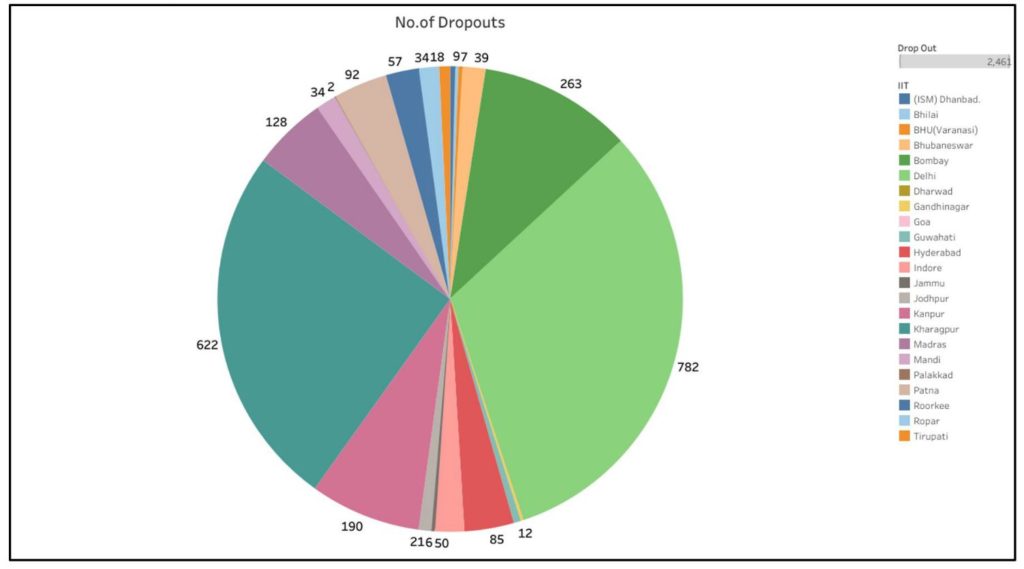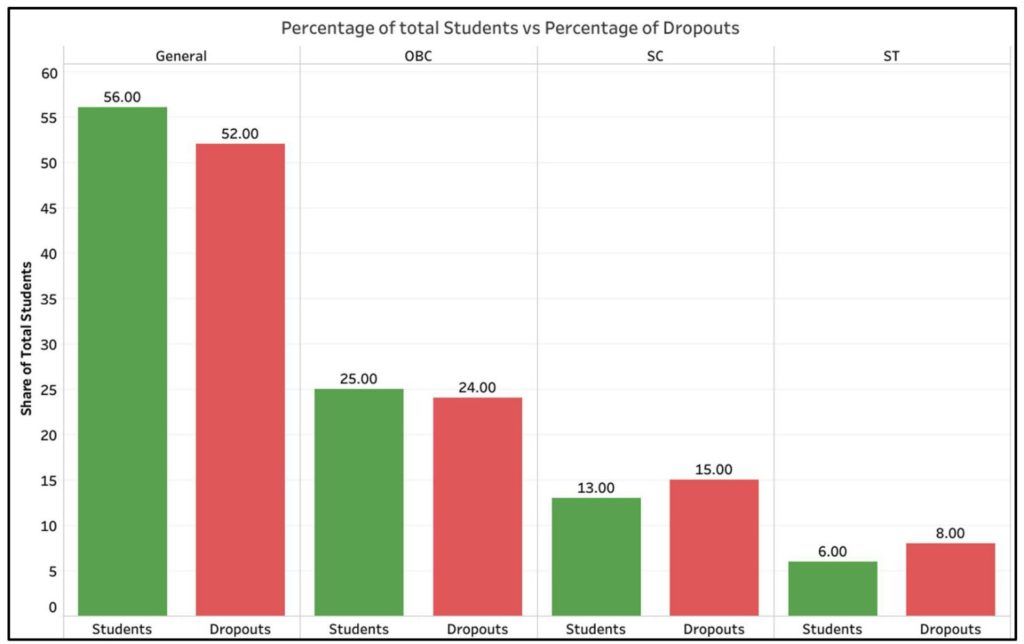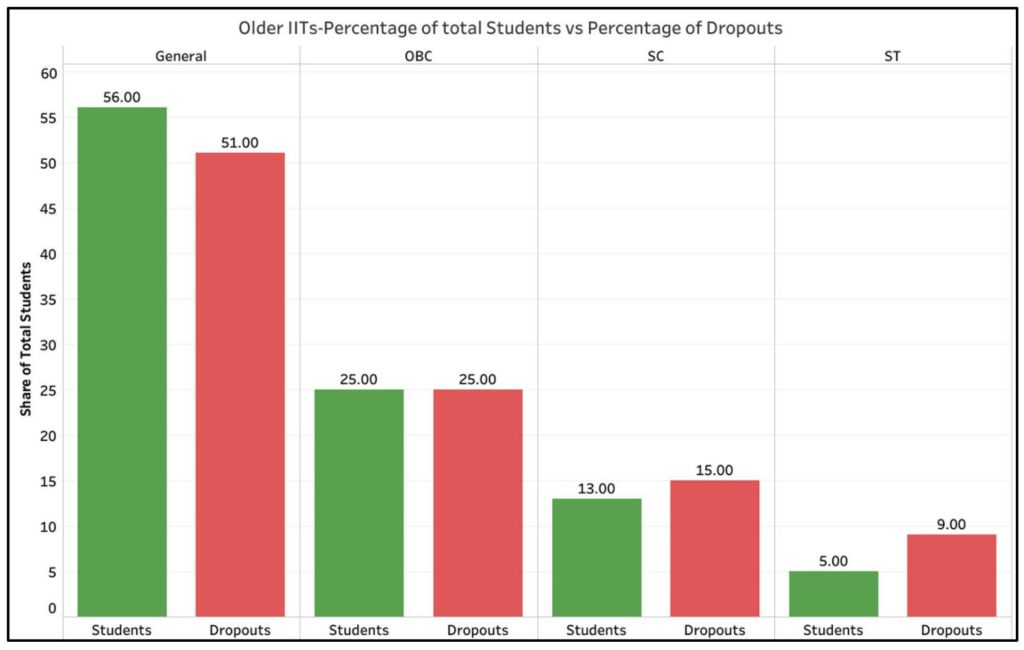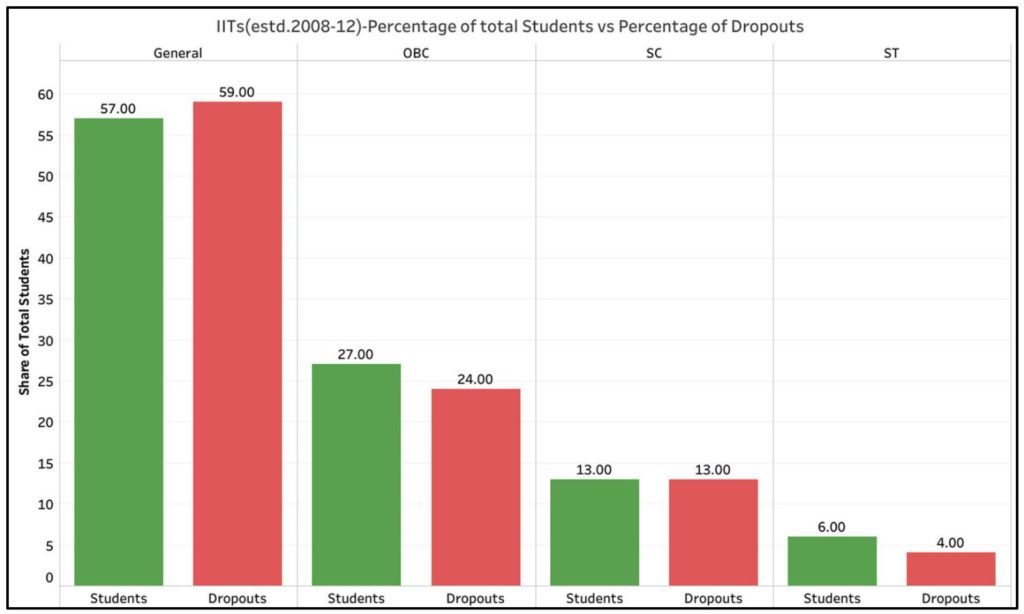[orc]The Government provided data on dropouts in IITs which led to multiple narratives being spread about the possible reasons for such dropouts. We analyse if the admission & dropout data from different IITs provides any additional insights.
IITs are the premier institutes for engineering in India, and many students across India aspire to study there. IIT JEE – Advanced, the entrance examination which determines the eligibility to join a IIT is considered to be one of the toughest in the world. Students across to country put in a lot of effort to do well in this exam and secure a seat in an IIT.
In view of the importance attached to securing a seat in the IITs, it does seem that students dropping out of IITs defies logic. The Minister for Human Resource Department, on 25 July 2019, answering a question in Rajya Sabha stated that 2461 students dropped out of IITs in the last two years.
This was duly reported by the mainstream media and various reasons have been cited for the dropouts, especially highlighting the aspect of caste discrimination. In this context, we analyse the numbers related to admissions and dropouts from various IITs to see if they provide any additional insights.
Nearly 87,000 Students study in IITs across India
There are 23 IITs located in different parts of India with approximately 85,000 students pursuing Undergraduate, Post graduated and PhD course in different streams.
In line with India’s policy of affirmative action (reservation), all the IITs reserves seats for various backward sections of the society. Currently 15%, 7.5% and 27% of the seats are reserved for SC, ST and OBC categories respectively, with the rest of the seats falling under General category.

About the Data used in this story
Information regarding the number of students studying in IITs every year is available on Council of Indian Institute of Technology website. However, the details for IIT Bombay and few of the new IITs including – Tirupati, Palakkad, Bhilai, Goa, Jammu, Dharwad for 2017-18 and 2018-19 are not available. The dropouts data provided in the answer in Rajya Sabha were for these two years. Hence, we have relied on the archives of JOSAA site (Joint Seat Allocation Authority), which provides the details of the seats allocated every year for each of the IITs. We took the cumulative totals of the various years of study to identify the number of students studying in 2017-18. We have also relied on Annual Reports of respective IITs which furnished the details.
Further, in order to avoid double counting of the students in 2017-18 and 2018-19, we took the average of the two years for the respective IITs. Hence the total numbers being presented are a near approximation of actual numbers.
Further, the number of students studying in IITs in this story refers to the total number of students in that IIT (including all years) and not just the number of students admitted in a specific year.
Dropouts constitute 2.9% of total student strength
Around 56% of the students studying in IITs across India fall under General Category. Students under OBC, SC & ST category constitute 25%, 13% and 6% respectively. Though the reservation for these categories is more than these numbers, all the seats in a specific category may not get filled up resulting in a lesser proportion of students from that category. It is also possible that students from the OBC, SC & ST categories may get seats in the general category based on merit.
Off the total 2461 students who dropped out as per the data provided by the government – 1290 belong to General category, while the dropouts in OBC, SC & ST categories are 601, 371 and 199 respectively. The dropout number is around 2.9% of the total student strength.

Share of OBC, SC & ST dropouts marginally more than their share in the number of students
Of all the dropouts in the last two years, 52% are from the General Category, while 24% belong to OBC, 15% to SC and 8% are ST category students.
The percentage of dropouts within the same category for General, OBC, SC & ST is – 2.68%, 2.74%, 3.3% and 4.20% respectively. In other words, 42 ST students drop out of 1000 ST students in IITs, while that number is around 27 in the general category. The percentage of dropouts is less than the national average in the General & OBC categories while it is more than the national average in the SC & ST categories.

Share of dropouts in the SC & ST categories higher among the IITs established prior to 2002
There are five IITs established between 1951 to 1963, which are IIT Kharagpur, Bombay, Madras, Kanpur and Delhi (in sequential order of their establishment). IIT Guwahati was established in the year 1994 followed by IIT Roorkee in 2001.
Together these IITs account for 71% of total IIT student strength in India. Of the total 2461 dropouts, 2054 dropouts i.e. 83.5% of the dropouts are from these IITs, which is higher than their share of the total IIT students. The percentage of students who dropped out from these 7 IITs is around 3.4% compared to the national average of around 2.9%.
The share of dropouts of each category is – General (51.2%), OBC (24.7%), SC (15.3%) & ST (8.8%). The respective share in dropouts of SC & ST category students is higher than their share in the total number of students in these IITs.
IIT Delhi has the highest share among SC and ST dropouts. Nearly 1% of SC students and 20% of ST students enrolled in IIT Delhi are among the dropouts. IIT Kharagpur is next with 7% of SC and 9% of ST students dropping out. This is higher than the average for the categories i.e. 4.04% (SC) and 5.55% (ST) dropouts within these categories for these 7 Older IITs.
It also needs to be noted that the dropout numbers for SC & ST category students in these IITs is higher than their respective numbers in all the IITs, which is 3.3% and 4.2% respectively.

Dropouts in IITs established between 2008-2012 were not only less but also the share of dropouts within the categories is even.
There were 8 new IITs were established in the year 2008, which includes IITs in: Bhubaneshwar, Hyderabad, Patna, Gandhinagar, Jodhpur, Ropar, Indore and Mandi. Four years later Banaras Engineering College was converted into IIT (BHU) in 2012.
Together these 9 IITs account for 18.7% of the total IIT students. There are 366 dropouts in the last two years i.e. 14.9% of the total dropouts.
The total of percentage of students dropping out from these 8 IITs was 2.3%, less than the national average of around 2.9%. Of the various categories, 2.35% General category students, 1.69% OBC, 2.02% SC and 2.13% ST category students dropped out as per government data.
IIT Ropar has a high share of ST and OBC dropouts with 13.56% and 14.81% of ST and OBC students dropping out. IIT Jodhpur has comparatively higher number of dropouts within the various categories with 7.58%, 7.33% and 7.69% of students from General, SC & ST categories respectively, dropping out.

Marginal number of dropouts in new IITs with IIT Tirupati having the largest share
Between 2015 and 2016, 6 new IITs were started in Palakkad, Tirupati, Goa, Jammu, Bhilai and Dharwad. There are around 2000 students studying in these IITs with 32 dropouts recorded in the last two years.
IIT Tirupati has 18 dropouts with 6 dropouts belonging to General and SC category each and 3 each for ST and OBC categories. Due to lack of data, the total number of students identified for these IITs were based on the base numbers and other admission data that was available.
Further, in 2016, Indian School of Mines was converted into IIT Dhanbad. It has 7124 students with only 9 dropouts of which 6 belong to general category.
Dropout percentage within SC and ST categories are higher in few IITs, but the specific reasons are not identified.
IIT Delhi, IIT Kharagpur and IIT Ropar do have a higher number of dropouts among the OBC, SC and ST categories compared to the national average. These IITs have contributed to the overall higher percentage of dropouts within these categories. Apart from these, the percentage of dropouts within each of these categories is uniform across most of the other IITs.
In the answer provided in Rajya Sabha, the HRD Minister mentioned that most of dropouts are from PG and Ph.D programme. The main reasons attributed include – shifting to other institutions, personal and medical reasons, study abroad, placements etc.
The reasons cited in the answer for dropouts in UG include – wrong choice of course, poor academic performance, personal and medical reasons etc. The answer further highlights the actions being initiated to address the academics and provide assisted learning, counselling for students regarding personal and psychological issues etc.
Although the numbers point to a marginally higher dropout among SC & ST students, these are specific to certain IITs as noted above. Further, there is no additional data to link of any of these cases to discrimination on the basis of caste, although such a reason cannot be ruled out. What is required at this stage is a comprehensive understanding of the reasons for dropouts, more specifically in the IITs noted above. Academic, sociological and financial issues could be few of the reasons affecting the students from marginalized communities, which can be resolved only when proper & relevant corrective measures are truly implemented.
Featured Image: Student dropouts in IITs



2 Comments
Pingback: India's unequal university system - CVR News Direct
Pingback: Marginalized castes and women are under-represented in many of the top academic institutions in the country | The Ambedkarite Today